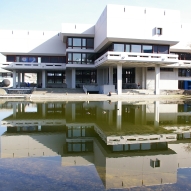| Dokumentenart: | Artikel | ||||
|---|---|---|---|---|---|
| Titel eines Journals oder einer Zeitschrift: | The Journal of Prosthetic Dentistry | ||||
| Verlag: | MOSBY-ELSEVIER | ||||
| Ort der Veröffentlichung: | NEW YORK | ||||
| Band: | 126 | ||||
| Nummer des Zeitschriftenheftes oder des Kapitels: | 4 | ||||
| Seitenbereich: | S. 575-580 | ||||
| Datum: | 2021 | ||||
| Institutionen: | Medizin > Lehrstuhl für Zahnärztliche Prothetik | ||||
| Identifikationsnummer: |
| ||||
| Stichwörter / Keywords: | PROVISIONAL CROWN; POLYMERIZATION SHRINKAGE; MECHANICAL-PROPERTIES; DENTAL PROSTHESES; TEMPORARY CROWN; BITE FORCE; CAD/CAM; FATIGUE; STRENGTH; | ||||
| Dewey-Dezimal-Klassifikation: | 600 Technik, Medizin, angewandte Wissenschaften > 610 Medizin | ||||
| Status: | Veröffentlicht | ||||
| Begutachtet: | Ja, diese Version wurde begutachtet | ||||
| An der Universität Regensburg entstanden: | Ja | ||||
| Dokumenten-ID: | 55776 |
 Web of Science
Web of ScienceZusammenfassung
Statement of problem. Interim restorations represent an essential clinical treatment step; however, limited information is available concerning the performance of computer-aided design and computer-aided manufacturing (CAD-CAM) interim materials. Purpose. The purpose of this in vitro study was to evaluate the performance and fracture load of resin anterior implant-supported interim fixed partial ...

Zusammenfassung
Statement of problem. Interim restorations represent an essential clinical treatment step; however, limited information is available concerning the performance of computer-aided design and computer-aided manufacturing (CAD-CAM) interim materials. Purpose. The purpose of this in vitro study was to evaluate the performance and fracture load of resin anterior implant-supported interim fixed partial dentures (IFPDs). Material and methods. Identical anterior resin IFPDs (maxillary central incisor to canine; n=16 per material) were milled from polymethylmethacrylate (PMMA) or di-methacrylate (DMA) systems with different filler content. The IFPD groups were split to simulate a chairside (cemented implant-supported prosthesis) or laboratory procedure (screw-retained implantsupported prosthesis). A cartridge DMA material served as a control. After interim cementation, combined thermocycling and mechanical loading (TCML) was performed on all restorations to approximate a maximum of 2.5 years of clinical function. Behavior during TCML and fracture force was determined, and failures were analyzed. The data were statistically investigated (Kolmogorov-Smirnov test, 1-way-ANOVA; post hoc Bonferroni, Kaplan-Meier survival, a=.05). Results. Drop out during TCML varied between no failures and complete failure during loading. For most systems, failure occurred between 120000 and 600000 mechanical loading cycles. For IFPDs without a screw channel fracture, values varied between 644 +/- 263 N and 987 +/- 101 N. Those with a screw channel fracture failed between 493 +/- 89 N and 951 +/- 248 N. Individual IFPDs had significantly higher mean fracture loads (P<.002), but the mean fracture values between IFPDs with and without a screw channel were not significantly different (P>.137). Failures were characterized by fracture of the connector (n=53) followed by mixed failures (n=22) or fractures at the abutment (n=21). Conclusions. These interim materials are sufficiently fracture resistant for the fabrication of implant-supported anterior IFPDs and are expected to survive between 6 months and 2 years before failure. The stability of IFPDs depended on the type of material but not on the restoration design (with or without a screw channel). (J Prosthet Dent 2021;126:575-8 0)
Metadaten zuletzt geändert: 29 Feb 2024 12:12



 Altmetric
Altmetric